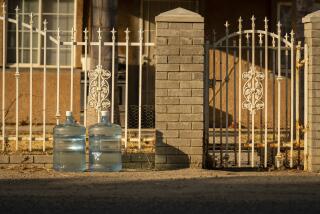Beverly Hills Urged to Reopen Old Water Wells for Quake Readiness
A citizens advisory committee has asked the city of Beverly Hills to consider reopening its abandoned water wells to protect the city from water shortages and potential water losses caused by earthquakes.
Beverly Hills, which has an abundant underground water supply, stopped using its own water in 1976 after the city decided it was more economical to purchase all of its water from the Metropolitan Water District.
“It may be cheaper economically, but you can’t drink your water savings during an earthquake. It is a false economic savings,” said Ellen Stern Harris, committee spokesman and a former representative for the city on the board of the Metropolitan Water District.
Shortages Are Possible
Harris said the city should consider reopening its wells because of potential shortages at the MWD and the possibility that a major earthquake could knock out water supplies, leaving Beverly Hills dry in the event of an emergency.
The City Council has been reluctant to redrill the wells because of the cost. A 1985 report by water consultant James Montgomery found that it was not economical to treat and deliver drinkable water from the city’s wells. The Water Master Plan for Beverly Hills, which cost $192,000, estimated that the city would have to pay $766 per acre-foot of its own water compared to $229 per acre-foot for water from the MWD, based on 1984 prices.
Instead of reopening the wells, the Montgomery report recommended that the city spend between $40 million and $45 million to repair existing reservoirs, pipelines and connectors to the MWD.
Changed His Mind
Councilman Benjamin H. Stansbury said he supported the development of an independent city supply of water until he learned what it would cost.
“I think it is important for the city to maintain an independent source of water, but I can’t support that goal if it is uneconomical,” he said.
Stansbury said he had once hoped that the city could use its underground water as a separate system to water lawns. The Montgomery report found that 40% of the residential water use in the city went to irrigate lawns.
The eight-member advisory committee appointed by Mayor Charlotte Spadaro asked the council to create a 10-member Water Advisory Committee to consider “water policy options.”
Stansbury said he would be willing to sit on the committee to oversee water management in the city. He said he would also approve the hiring of an additional consultant to review the findings in the Montgomery report.
Supplemental Source
Mayor Spadaro also called for further study. “We do need to investigate the possibility of having our own water supply. The MWD was never intended to be a first source for any city. It was supposed to be a supplemental supply.”
In fact, the MWD encourages its agencies to seek additional sources of water.
“It is valuable to all of us if each local agency can develop its own water supplies. It places less of a burden on MWD and all the agencies we represent stretching from Ventura to the Mexican border,” said Carl Boronkay, general manager for the MWD.
Boronkay said the water district has a program in which it offers financial help to member agencies to develop their own water sources. But no such arrangement has been made in Beverly Hills, he said.
Boronkay said earthquakes do not pose a major problem to the delivery of water because water facilities are built to withstand tremendous shocks. “We have facilities built right near earthquake faults,” he said. “We have a facility right near the epicenter of the Palm Springs earthquake. It caused little damage. We were shut down for about an hour.”
More to Read
Sign up for Essential California
The most important California stories and recommendations in your inbox every morning.
You may occasionally receive promotional content from the Los Angeles Times.










